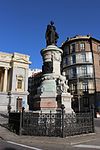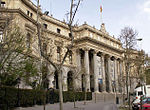Church of Saint Jerome the Royal

Saint Jerome the Royal (in Spanish San Jerónimo el Real) is a Roman Catholic church from the early 16th-century in central Madrid (Spain). The church, which has undergone numerous remodelings and restorations over the centuries is the remaining structure of the Hieronymite monastery that once stood beside the royal palace of Buen Retiro, of which a portion now serves as the Prado museum. Its proximity to the royal palace also underscores a connection to royalty, serving for centuries as the church used for the investiture of the Prince of Asturias. In addition, a Mass to celebrate the investiture of King Juan Carlos I was held here. In part, this link was cemented also because Madrid only completed its Cathedral of the Almudena in 1993. For many centuries, the Church of San Isidro served as a de facto cathedral, but while this church was associated with the patron saint of Madrid, St. Isidore was also the patron of manual laborers, not royalty, thereby relegating the role of royal chapel to this church.
Excerpt from the Wikipedia article Church of Saint Jerome the Royal (License: CC BY-SA 3.0, Authors, Images).Church of Saint Jerome the Royal
Calle Moreto, Madrid Retiro
Geographical coordinates (GPS) Address External links Nearby Places Show on map
Geographical coordinates (GPS)
| Latitude | Longitude |
|---|---|
| N 40.414514 ° | E -3.691138 ° |
Address
Parroquia San Jerónimo el Real (Iglesia de los Jerónimos)
Calle Moreto 4
28014 Madrid, Retiro
Community of Madrid, Spain
Open on Google Maps











